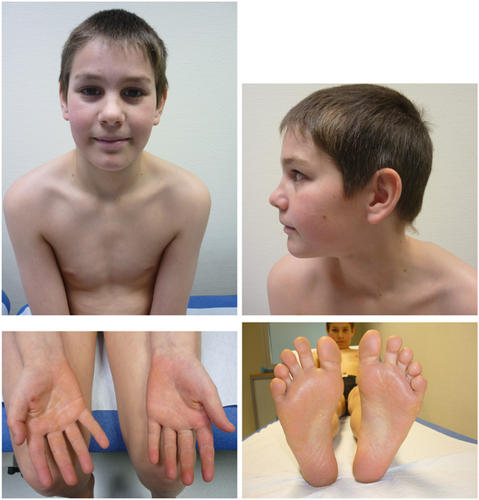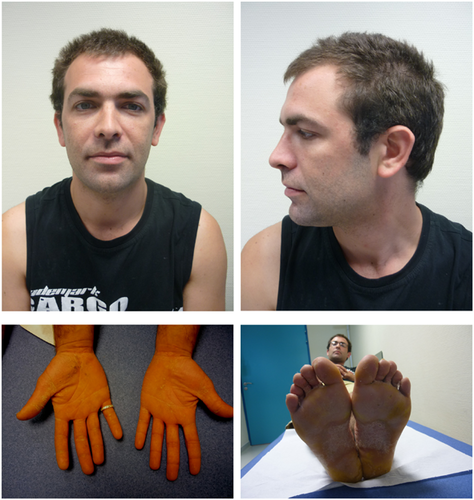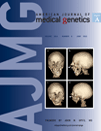Palmo-Plantar hyperkeratosis, intellectual disability, and spastic paraplegia in two maternal half brothers: Further evidence for an X-linked inheritance
Abstract
In 1983, Fitzsimmons et al. reported four brothers with an unrecognized disorder characterized by intellectual disability, spastic paraplegia, and palmo-plantar hyperkeratosis (OMIM 309500). In this report, we describe a family in which two males, maternal half-brothers, had learning disabilities. Both patients also showed spasticity in the lower limbs and palmo-plantar hyperkeratosis. The mother of the affected boys had learning difficulties but did not show any dermatological symptoms. This report confirms that the association of features reported by Fitzsimmons et al. is a distinct entity and further suggests an X-linked mode of inheritance. © 2013 Wiley Periodicals, Inc.
INTRODUCTION
In 1983, Fitzsimmons et al. reported four brothers with an unrecognized disorder characterized by intellectual disability, spastic paraplegia, and palmo-plantar hyperkeratosis (OMIM 309500). No other patient has been reported since then. In this report, we describe two maternal half-brothers with palmo-plantar hyperkeratosis, mild intellectual disability, and spastic paraplegia.
CLINICAL REPORT
Patient 1
The first patient was born at 37 weeks of gestation to unrelated and healthy parents. The pregnancy was uneventful. He walked independently at 13 months. No speech delay was noted. Later on, he displayed learning disabilities and could not follow normal school. At the age of 26, his weight was 75 kg (+0.5 SD), his length was 182 cm (+1 SD), and occipitofrontal circumference (OFC) was 59.5 cm (+1.5 SD). Physical examination showed moderate diffuse non-transgrediens bilateral yellow palmo-plantar hyperkeratosis with fissures (Fig. 1). No facial dysmorphy was noted (Fig. 1). Neurological examination showed mild tremors in the upper limbs with spread and brisk reflexes, bilateral extensor plantar responses, and bilateral pes cavus deformity. He was able to read and write short sentences with difficulty. Laboratory investigations were normal including blood count, electrolytes, uric acid, thyroid, renal and liver functions, and urinary creatine, and guanidoacetate.

Patient 2
The second patient, the propositus' maternal half-brother, was born at 41 weeks of gestation. The pregnancy was uneventful. Birth weight was 3,150 g (−0.5 SD), length was 50.5 cm (mean), and OFC was 33 cm (−1 SD). He walked independently at 11 months but showed language delay: first words were pronounced at the age of 3. He showed mild learning disabilities and could not follow normal school. At 11 years of age, his weight was 37.5 kg (+1.5 SD), his height was 145.5 cm (+0.5 SD), and his OFC was 52 cm (−1.5 SD). Physical examination showed a high palate without facial anomalies and mild non-transgrediens diffuse palmo-plantar hyperkeratosis with accentuated palmo-plantar markings (Fig. 2). Neurological examination showed brisk reflexes, mild hypertonia in his lower limbs, bilateral extensor plantar responses, and mild ataxia with postural and kinetic tremors in the hands. He walked on his toes without muscle weakness or motor deficit. A brain MRI did not show any abnormality. Electromyography was normal. Lower limb somatosensory evoked potentials revealed an increased conduction time along both lemniscal pathways (right > left) with slightly reduced amplitude of the cortical waves. Motor evoked potentials showed normal central conduction time but amplitude was markedly reduced on the right tibialis anterior muscle. Upper limb MEPs were normal. Vitamin E levels were slightly elevated: 12.2 mg/L (normal range 4.5–9.3 mg/L). Plasmatic very-long-chain fatty acids (VLCFAs) dosage was normal.

Array CGH (Agilent Human Genome CGH 60K oligonucleotide array), FMR1 methylation pattern, and DNA mitochondrial analyses (mutations 3243, 3250, 3251, 3252, 3256, 3260, 3271, 3291, 3302, 30303, 8344, 8356, 8993, 9176, 13513, 13514) were normal.
Their mother was 48 years old and had two other children: a 28-year-old daughter who did not show any neurological or dermatological problems and a 25-year-old son affected by Down syndrome without any palmo-plantar hyperkeratosis or clinical signs for spastic paraplegia.
Her weight, length, and OFC were 63 kg (+1.8 SD), 161 cm (−0.4 SD), and 56 cm (+1.0 SD), respectively. Dermatological examination was normal. She showed no motor disabilities. Neurological examination showed brisk reflexes, left Babinski sign, and mainly postural hand tremor. She did not show speech delay but had moderate school learning difficulties and had not obtained any diplomas. She was working as a housemaid.
X-chromosome inactivation (XCI) analysis has been performed in the mother. Methylation of the HpaII restriction site near a polymorphic (CAG)n repeat in the AR gene (androgen receptor) was not informative. Analysis at the FMR1 locus suggested skewed X-inactivation pattern despite it was not totally skewed (<95%).
DISCUSSION
We report on two half-brothers with palmo-plantar hyperkeratosis, mild learning disability, and spastic paraplegia further suggesting an X-linked inheritance.
Hereditary spastic paraparesis (HSP) represents a group of inherited disorders in which the predominant clinical features are progressive lower limb spasticity and pyramidal weakness, with hyperreflexia and extensor plantar responses. The genetics of HSP are complex and several modes of inheritance (autosomal dominant, autosomal recessive, and X-linked recessive) have been described [Salinas et al., 2008].
It is usual to distinguish pure HSP in which progressive spastic paraparesis is the prominent feature and complex HSP which can comprise additional clinical features including amyotrophy, cardiac defects, sensorineural deafness, dementia, epilepsy, extrapyramidal disease, sensory neuropathy, and ophthalmological abnormalities.
The association of HSP and dermatological symptoms has previously been reported in a few rare syndromes. The first neurocutaneous disorder that could be discussed in relation to our family is the Sjögren–Larsson syndrome (OMIM 270200). This is an autosomal recessively inherited disorder caused by the deficiency of fatty aldehyde dehydrogenase due to mutations in the ALDH3A2 gene [Rizzo et al., 1999]. Patients affected by this syndrome show ichthyosis, intellectual disability, spastic paraparesis, and macular dystrophy. The dermatological lesions observed in our patients are different, as they do not present generalized lamellar ichthyosis but palmo-plantar hyperkeratosis. An autosomal mode of inheritance is also very unlikely in this family as the fathers of the two boys are unrelated.
The association of intellectual disability, neurological abnormalities, and dermatological lesions has also been reported in X-linked ichthyosis. Microdeletions at the Xp22.31 locus are associated with X-linked ichthyosis, intellectual disability, and attention deficit hyperactivity disorder [Tiepolo et al., 1980; Van Esch et al., 2005]. Ichtyosis results from steroid sulfatase deficiency, caused by deletion of the STS gene while the other clinical features are supposed to be caused by additional deleted genes located in the Xp22.31 region. Our patients showed palmo-plantar hyperkeratosis rather than generalized ichthyosis and the absence of deletion at the Xp22.31 locus by array CGH performed in Patient 2 allowed us to rule out this microdeletion syndrome.
Recently, Aldahmesh et al. [2011] reported mutations in the ELOVL4 gene in two unrelated patients with a neurocutaneous syndrome. Patients exhibited congenital ichthyosis, intellectual disability, seizures, and spastic quadriplegia. Although our patients do not show the same phenotype, we performed VLCFAs dosage which was normal and ruled out this disorder.
To our knowledge, the only patients with association of HSP, palmo-plantar hyperkeratosis, and intellectual disability were reported by Fitzsimmons et al. [1983]. They reported a family of four brothers aged from 16 to 35 with intellectual disability, spastic paraplegia with pes cavus and palmo-plantar hyperkeratosis. Three of them had poor speech with severe intellectual disability and severe neurological symptoms. The fourth affected brother had learning disabilities, mild bilateral pes cavus, increased reflexes in the lower limbs, and hyperkeratosis of his soles. The mother was of normal intelligence but had plantar hyperkeratosis. Her three daughters were normal. Karyotype and routine biological exams were normal. The phenotype observed in our patients is milder but very similar to the one described by Fitzsimmons. No molecular abnormality has been identified in this family since the original report.
In conclusion, our report describes two maternal half-brothers with palmo-plantar hyperkeratosis, mild intellectual disability, and neurological abnormalities. This phenotype is very similar to the one reported by Fitzsimmons et al. [1983]. Further reports will confirm the mode of inheritance and hopefully lead to the identification of the molecular basis of this probable monogenic disorder.
ACKNOWLEDGMENTS
We are grateful to all the members of this family for their cooperation, to Dr Patrizia Bonneau for mitochondrial DNA molecular analysis and to Dr Martine Raynaud for X-inactivation study.




